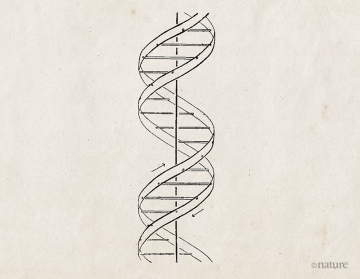Georgina Ferry in Nature:
 On 25 April 1953, James Watson and Francis Crick announced1 in Nature that they “wish to suggest” a structure for DNA. In an article of just over a page, with one diagram (Fig. 1), they transformed the future of biology and gave the world an icon — the double helix. Recognizing at once that their structure suggested a “possible copying mechanism for the genetic material”, they kick-started a process that, over the following decade, would lead to the cracking of the genetic code and, 50 years later, to the complete sequence of the human genome. Until that time, biologists had still to be convinced that the genetic material was indeed DNA; proteins seemed a better bet. Yet the evidence for DNA was already available. In 1944, the Canadian–US medical researcher Oswald Avery and his colleagues had shown2 that the transfer of DNA from a virulent to a non-virulent strain of bacterium conferred virulence on the latter. And in 1952, the biologists Alfred Hershey and Martha Chase had published evidence3 that phage viruses infect bacteria by injecting viral DNA.
On 25 April 1953, James Watson and Francis Crick announced1 in Nature that they “wish to suggest” a structure for DNA. In an article of just over a page, with one diagram (Fig. 1), they transformed the future of biology and gave the world an icon — the double helix. Recognizing at once that their structure suggested a “possible copying mechanism for the genetic material”, they kick-started a process that, over the following decade, would lead to the cracking of the genetic code and, 50 years later, to the complete sequence of the human genome. Until that time, biologists had still to be convinced that the genetic material was indeed DNA; proteins seemed a better bet. Yet the evidence for DNA was already available. In 1944, the Canadian–US medical researcher Oswald Avery and his colleagues had shown2 that the transfer of DNA from a virulent to a non-virulent strain of bacterium conferred virulence on the latter. And in 1952, the biologists Alfred Hershey and Martha Chase had published evidence3 that phage viruses infect bacteria by injecting viral DNA.
Watson, a 23-year-old US geneticist, arrived at the Cavendish Laboratory at the University of Cambridge, UK, in autumn 1951. He was convinced that the nature of the gene was the key problem in biology, and that the key to the gene was DNA. The Cavendish was a physics lab, but also housed the Medical Research Council’s Unit for Research on the Molecular Structure of Biological Systems, headed by chemist Max Perutz. Perutz’s group was using X-ray crystallography to unravel the structures of the proteins haemoglobin and myoglobin. His team included a 35-year-old graduate student who had given up physics and retrained in biology, and who was much happier working out the theoretical implications of other people’s results than doing experiments of his own: Francis Crick. In Crick, Watson found a ready ally in his DNA obsession.
More here.
